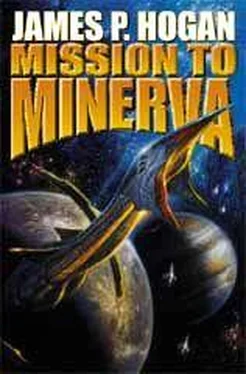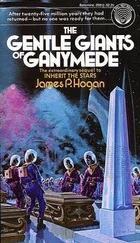A peculiar implication of the whole state of affairs was that if they were sending particle-energy quanta into nearby other universes, then at least some versions of their other selves who lived in those universes would be doing the same thing too. This suggested that, in principle anyway, it might be possible to detect electrons, protons, molecules, or whatever materializing here as a result of corresponding experiments going on next door. The Thuriens had been looking for such events, but the results so far had been negative. From VISAR's latest computations, it seemed that such a result was to be expected. Porthik Eesyan explained why to Hunt while they were observing some of the test runs to multiport molecules. It was several days since the Tramline group's arrival. The introductory tours and demonstrations of the Multiporter, as the project had come to be designated, were over. The combined team were getting down to business. Hunt and Eesyan were both physically there, not neurally coupled in remotely to a composite creation. Experimenters couldn't do much real experimenting in one of VISAR's virtual-world settings.
"Is your head in a mood for big numbers today, Vic?" Eesyan stood over a foot taller than Hunt, dark gray, almost black in hue, his torso covered by a loose-fitting coat that reached to the knees, brightly colored in an elaborate woven design. Ganymeans did not posses hair, but the skin at the tops of their heads roughened into a ribbed, scaly texture, a bit like candlewick, that could range through as many color combinations and hues as bird plumage. Eesyan's was blue and green, taking on streaks of orange toward the rear.
"I'm ready to risk it. Try me," Hunt said.
"Multiverse branches really are as thin as some of us have speculated. In theory, they could differ by as little as a single quantum transition. There could be as many of them as the number of discrete quantum transitions in the entire lifetime of the universe. Pick anything you like for the number of zeros. It won't make any difference that matters."
Hunt pursed his lips in a silent whistle while he thought about it.
Considering the enormity of what it implied, the Multiporter was really quite a modest piece of hardware as Thurien constructions went. The projection chamber itself, which was where the actual multiporting happened, took the unremarkable form of a square metal housing about the size of a microwave oven, upon which an array of shiny tubes converged at various angles from pieces of equipment mounted in a supporting framework extending around the sides, overhead, and into a bay beneath. A forest of sensors and instrumentation filling the remainder of the framework, a worktop and monitoring station, several desks, and banks of conduits, tubes, and other connections disappearing behind the walls and down through the floor completed the scene. The chamber at the center was where matter was being induced to disappear into other realities. It was adequate for the type of experiments being conducted currently. Should success later lead to more ambitious attempts involving larger objects, it was anticipated that a scaled-up Multiporter would be operated out in space, away from Thurien. Eesyan already had some designers looking into it. Short-term budget cutting was meaningless in a system that had no concept nor need of cost accounting.
A volume of space inside the chamber was also where the attempts were being made to detect matter multiported from other realities. By the bizarre logic of the situation, if other nearby selves were multiporting matter out of their universe using their version of the same equipment, then it seemed to follow that this would be the place to look for it in this universe. Hence, the Multiporter's time was divided between operating in sending and detecting modes. This raised the question that if their other selves were working to the same schedule, nobody would detect anything because they would all be sending when no one was looking, and looking when no one was sending. The answer adopted was to use a local quantum randomizer to switch between modes. Assuming their counterparts would think the same thing, the idea was that random generators driven by a different sequence of quantum processes-which was what, by definition, made a different reality different-would yield a different pattern of switching times, giving periods of overlap between modes of sending from one universe and attempting detection in another. The negative outcome had caused this line of supposition to be reexamined without any obvious flaw turning up, but Eesyan was now saying there were other reasons why it was to be expected.
A "segment" was the term that had been given to a "vertical" slice of the Multiverse-a self-contained universe that beings like Thuriens and humans inhabited, and within which change in the form of an ordering of events was perceived to happen. In terms of the not really accurate but more easily visualized analogy of pages in a book, it appeared that the pages were astoundingly thin. "It seems to be the way some people guessed," Eesyan confirmed. "A particle traveling through a segment would exist in it for a vanishingly short time, making it indistinguishable from background quantum noise. Impossible to detect in practice."
Hunt had hoped for some kind of bulk averaging effect whereby individual quantum events would seldom give rise to any discernible difference at higher, more macroscopic levels. That would, in effect, have made the pages thicker. But he wasn't about to argue with VISAR over a matter of computation. "Do macroscopic probabilities get bigger?" he asked Eesyan. In other words, would larger objects take longer to traverse a segment, making their detection easier?
"Not significantly," Eesyan answered. "Multiporting propagation is fast." He made a tossing-away motion with his six-fingered hand. "But we're working toward sending larger configurations of matter. We will upgrade the detectors to look for the same kind of thing, too, anyway. You never know. We might glimpse something passing through."
Hunt rested his elbows on the guard rail in front of them and snorted in a way that said this still took some effort to believe. By the strange reasoning that guided the planning, there would be little point in looking for objects from next door that they were not themselves yet in a position to send. He stared up at the resonator mountings, where the tubes emerged from overhead. That was where the energy was imparted and the matrix waves-"M-waves," by the terminology being formulated-generated to initiate the multiporting process. Thurien technicians assisted by maintenance robots were working on parts of the equipment. Josef was up there, too, with Chien, hovering in a Thurien gravitic bubble, to see what they could learn.
"So what happens finally to the extended structures that you've been sending?" Hunt asked Eesyan. "The molecular configurations."
"We've no way of knowing for sure. From what we can tell, they just keep going and disperse as an expanding wave function."
Hunt nodded distantly. How, then, had the relay device that had appeared in Earth orbit been able to maintain itself there long enough to initiate and support a dialogue? Did it mean that only objects that were complex enough to contain some means of "stopping" themselves somehow could be multiported into another reality in the meaningful sense of being able to stay there?
"There's a lot to be done yet," Eesyan said, as if reading his thoughts.
At that moment, VISAR came though via avco in Hunt's head to say he had a call from Mildred. Since it was disconcerting-and certainly not the best of manners-for someone to suddenly start talking to thin air when they were with company, VISAR would have announced the event to Eesyan, too. Such courtesies were not possible on Earth, where most people didn't have avcos behind their ears, which was another reason why Hunt generally refrained from using his when back home. Those who did were not the kind who worried unduly about manners anyway. He accepted, and Mildred appeared as a framed head and shoulders superposed in his visual field.
Читать дальше











